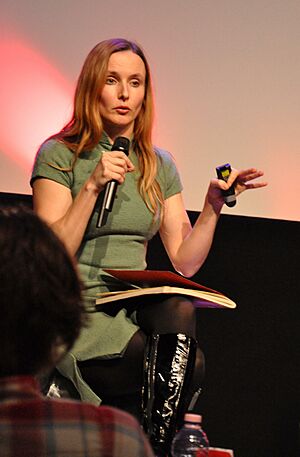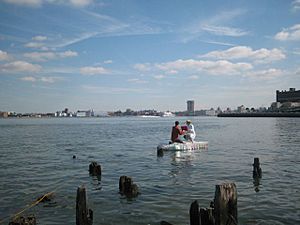Natalie Jeremijenko facts for kids
Quick facts for kids
Natalie Jeremijenko
|
|
|---|---|

Natalie Jeremijenko in 2009
|
|
| Born | 1966 (age 58–59) Mackay, Queensland, Australia
|
| Nationality | Australian |
| Alma mater | |
| Style | net.art |
| Movement | Experimental design |
| Spouse(s) | Dalton Conley (div.) |
Natalie Jeremijenko is an Australian artist and engineer. She was born in 1966. She has studied many subjects, including science and engineering.
Natalie is part of the net.art movement. This means she uses the internet and technology in her art. Her work often explores how people, the environment, and technology connect. She calls her work "X Design," which stands for "experimental design." She also calls herself a "thingker," meaning she makes things and thinks deeply about them.
Natalie describes her work as "socio-ecological systems design." This means she designs systems that help both society and the environment. She uses her engineering skills to create public art projects. These projects highlight important social issues. They also focus on how humans interact with our planet.
Contents
Early Life and Learning
Natalie Jeremijenko was born in Mackay, Queensland, Australia. She grew up in Brisbane. She was one of ten children. Her parents were a doctor and a teacher. They loved new home technology. Natalie says her mom was the first woman in Australia to own a microwave oven.
She earned a PhD in computer science and electrical engineering. This was from the University of Queensland. She also studied mechanical engineering at Stanford University.
| Year | Degree | University | Details |
|---|---|---|---|
| 1992 | BFA (with Honors) | Royal Melbourne Institute of Technology | Focused on digital information and virtual reality. |
| 1993 | BS (Conferred) | Griffith University, Queensland, Australia | Studied neuroscience and biochemistry. |
Natalie was married to sociologist Dalton Conley. They had two children. She also has another daughter from a previous relationship.
Her Career Journey
In the 1990s, Natalie Jeremijenko worked as an artist-in-residence. This was at Xerox PARC in Palo Alto, California.
In 2018, she was an Artist in Residence at Dartmouth College. Today, she is a professor at New York University. She teaches in the Visual Art Department. She also works with the Computer Science and Environmental Studies departments.
Creative Projects
Natalie Jeremijenko created art under the name Bureau of Inverse Technology (BIT). This was a group of artists who worked in art and technology. BIT started in the early 1990s. They were based in Australia, California, and Germany.
Films and Talks
BIT Plane, 1998
The BIT plane was a small, radio-controlled model aircraft. The Bureau of Inverse Technology designed it. It had a tiny video camera and transmitter. In 1997, it flew over Silicon Valley. It took aerial videos of the area.
A pilot on the ground guided the plane using the live video feed. This allowed it to fly into the heart of the Information Age. Many corporate research parks in Silicon Valley are "no-camera zones." The BIT plane flew secretly through these areas. It captured hours of aerial footage.
The Art of The Eco-mindshift, 2009
Natalie Jeremijenko gave a TED Talk in October 2009. In her talk, she discussed her projects. She also shared what she was working on with the Environmental Health Clinic. She talked about her plans to improve the environment. This included ideas for busy places like New York City.
Art Installations
In 1988, Natalie helped start the Livid rock festival in Brisbane. She says this experience helped her move towards public art. She created installations that appealed to young people.
Designed 4 Political Action
This project was a collection of tools and ideas. It was for political involvement and direct action. The Bureau of Inverse Technology and others developed it. Wired Magazine called it "the DARPA of dissent."
Live Wire (Dangling String), 1995
In 1995, Natalie was an artist-in-residence at Xerox PARC. She created an art installation there. It was made of spinning strings. The strings changed speed based on how much internet traffic there was. This work is seen as an early example of "calm technology." It was placed in an office. It helped people think differently about technology.
OneTree(s), 1999
OneTree(s) was a public experiment. It showed information about environmental and cultural issues. Natalie grew one hundred trees that were clones from a single original tree. This project explored topics like global warming and air quality. It also looked at genetically modified organisms. This art installation encouraged people to think for themselves. It used information and conceptual art to share science. It presented information without using charts or graphs.
OOZ
OOZ was a series of exhibitions in 2006. Animals pressed buttons to make human speech. This project was shown at Mass MoCA.
Feral Robots
This is an open source robotics project. It helps people upgrade robotic dog toys. It also helps organize "Feral Robotic Dog Pack Release" events. The robot dogs can follow pollution. When they are released, they help people see information about contaminants. This allows more people to join discussions. It also helps the public participate in environmental monitoring.
Tree Logic, 1999 - 2023
For Tree Logic, Natalie Jeremijenko hung six live flame maple trees upside down. They were in a courtyard at the Massachusetts Museum of Contemporary Art (MASS MoCA). Even though they were upside down, the trees still grew towards the sun. This created unusual shapes. It made people wonder about what is truly "natural."
Biotech Hobbyist magazine
This is an online magazine. It provides kits and resources for biotech projects at home. The goal is to help people understand biotech better. It also aims to increase public involvement in decisions about the future of biotechnology.
Bat Billboard, 2008
This project was created in 2008. Its goal was to correct wrong information about bats. It also educated people about bats, their homes, and their activities. The billboard was an interactive home for bats. It displayed written messages based on the sonar messages the bats sent. This work was shown at MoMA's 2011 exhibit "Talk to Me."
Environmental Health Clinic, 2009
This clinic helped people with their environmental concerns. It "prescribed" design solutions to "impatients." These were people who were "too impatient to wait for legislative change." For example, people worried about water quality were told to put tadpoles into water samples. Tadpoles are sensitive to pollution. They were also told to name each tadpole after a government official. These officials could make decisions affecting water quality.
xAirport, 2010
This project was designed with Fletcher Studio. It was a temporary wetland airport. It was installed at the San Jose Biennial in September 2010. The idea was to "reimagine" how we fly. This project worked with the xAirport team. It also worked with ICON A5 to develop a light aircraft for wet landings.
Online Projects
HowStuffIsMade, 2005 - ongoing
How Stuff is Made (HSIM) is a visual encyclopedia. It documents how products are made. It also shows their environmental costs and labor conditions. This is a wiki-based project created by students. It aims to change the information available about making materials. Each semester, students in Natalie's course at NYU research products. They create photo essays for this wiki. The work was shown at the International Symposium on Electronic Art (ISEA) in 2006.
Awards and Recognition
- 2013 Creative Capital Emerging Fields Award
- 2011 Fast Company's Most Influential Women in Technology
- 2005 I.D. magazine annual Forty (#37)
- 1999 Rockefeller Fellow
- 1999 Technology Review's Top 100 Young Innovators
Selected Projects Timeline
| Year | Title | Type |
|---|---|---|
| 2010 | xAirport | Installation |
| 2004 | Clear Skies: FaceMasks | Project |
| 1999 | Tree Logic | Installation |
| 1998 | Onetree | Installation |
| Bitplane | Film | |
| 1997 | ALifeTree | Project |
| 1996 | Voice Box | Installation |
| 1995 | Live Wire | Installation |
| 1993 | The Bureau of Inverse Technology | Film |
See also
- Bureau of Inverse Technology
- Critical technical practice


